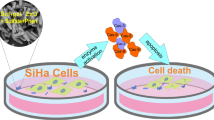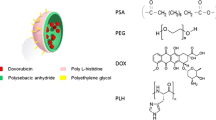Abstract
In this study, the preparation of poloxamer 188-coated poly(butyl cyanoacrylate) colloidal nanospheres of controlled size distribution and their physicochemical characterisation were investigated and their cytotoxic effects in cervical carcinoma (HeLa) cells evaluated. The nanoparticles were prepared by controlled emulsion polymerisation of butyl cyanoacrylate in an aqueous medium containing poloxamer 188 as an amphiphilic non-ionic colloidal stabiliser. The colloids thus obtained were characterised by scanning electron microscopy, dynamic and electrophoretic light-scattering, Fourier transform infrared spectroscopy (FTIR) and nuclear magnetic resonance (NMR) spectroscopy. The average size of the particles could be finely controlled within an interval between 220 nm and 290 nm by varying the concentration of the precursor and citric acid in the polymerisation medium. The particle zeta-potentials in phosphate-buffered saline were approximately −4.5 mV. FTIR and NMR data confirmed the expected composition of nanoparticles and the complete precursor polymerisation. In-vitro studies with cervical carcinoma (HeLa) cells demonstrated the dose-dependent cytotoxicity of nanoparticles (IC50 ≈ 30 εg mL−1). Observations by phase contrast and fluorescence microscopy revealed that at cytotoxic concentrations (40 εg mL−1) nanoparticles induced changes in cell morphology and chromatin fragmentation. The colloidal stabiliser (poloxamer 188) alone was not cytotoxic at the applied concentrations.
Similar content being viewed by others
References
Aggarwal, P., Hall, J. B., McLeland, C. B., Dobrovolskaia, M. A., & McNeil, S. E. (2009). Nanoparticle interaction with plasma proteins as it relates to particle biodistribution, bio-compatibility and therapeutic efficacy. Advanced Drug Delivery Reviews, 61, 428–437. DOI: 10.1016/j.addr.2009.03.009.
Alonso, M. J., Sanchez, A., Torres, D., Seijo, B., & Vila-Jato, J. L. (1990). Joint effects of monomer and stabilizer concentrations on physico-chemical characteristics of poly(butyl 2-cyanoacrylate) nanoparticles. Journal of Microencapsulation, 7, 517–526. DOI: 10.3109/02652049009040475.
Ambruosi, A., Khalansky, A. S., Yamamoto, H., Gelperina, S. E., Begley, D. J., & Kreuter, J. (2006). Biodistribution of polysorbate 80-coated doxorubicin-loaded [14C]-poly(butyl cyanoacrylate) nanoparticles after intravenous administration to glioblastoma-bearing rats. Journal of Drug Targeting, 14, 97–105. DOI: 10.1080/10611860600636135.
Arias, J. L., Gallardo, V., Ruiz, M. A., & Delgado, A. V. (2008). Magnetite/poly(alkylcyanoacrylate) (core/shell) nanoparticles as 5-fluorouracil delivery systems for active targeting. European Journal of Pharmaceutics and Biopharmaceutics, 69, 54–63. DOI: 10.1016/j.ejpb.2007.11.002.
Behan, N., Birkinshaw, C., & Clarke, N. (2001). Poly n-butyl cyanoacrylate nanoparticles: a mechanistic study of polymerisation and particle formation. Biomaterials, 22, 1335–1344. DOI: 10.1016/s0142-9612(00)00286-6.
Cruz, T., Gaspar, R., Donato, A., & Lopes, C. (1997). Interaction between polyalkylcyanoacrylate nanoparticles and peritoneal macrophages: MTT metabolism, NBT reduction, and NO production. Pharmaceutical Research, 14, 73–79.
Douglas, S. J., Illum, L., Davis, S. S., & Krueter, J. (1984). Particle size and size distribution of poly(butyl-2-cyanoacrylate) nanoparticles: I. Influence of physicochemical factors. Journal of Colloid and Interface Science, 101, 149–158. DOI: 10.1016/0021-9797(84)90015-8.
Douglas, S. J., Davis, S. S., & Holding, S. R. (1985). Molecular weights of poly(butyl 2-cyanoacrylate) produced during nanoparticle formation. British Polymer Journal, 17, 339–342. DOI: 10.1002/pi.4980170404.
Douglas, S. J., Illum, L., & Daviss, S. S. (1986). Poly(butyl 2-cyanoacrylate) nanoparticles with differing surface charges. Journal of Controlled Release, 3, 15–23. DOI: 10.1016/0168-3659(86)90060-x.
Evangelatov, A., Skrobanska, R., Mladenov, N., Petkova, M., Yordanov, G., & Pankov, R. (2014). Epirubicin loading in poly(butyl cyanoacrylate) nanoparticles manifests via altered intracellular localization and cellular response in cervical carcinoma (HeLa) cells. Drug Delivery. DOI: 10.3109/10717544.2014.962117. (in press)
Gulyaev, A. E., Gelperina, S. E., Skidan, I. N., Antropov, A. S., Kivman, G. Y., & Kreuter, J. (1999). Significant transport of doxorubicin into the brain with Polysorbate 80-coated nanoparticles. Pharmaceutical Research, 16, 1564–1569. DOI: 10.1023/a:1018983904537.
Hashizume, H., Baluk, P., Morikawa, S., McLean, J. W., Thurston, G., Roberge, S., Jain, R. K., & McDonald, D. M. (2000). Openings between defective endothelial cells explain tumor vessel leakiness. The American Journal of Pathology, 156, 1363–1380. DOI: 10.1016/s0002-9440(10)65006-7.
Kagan, V. E., Bayir, H., & Shvedova, A. A. (2005). Nano-medicine and nanotoxicology: two sides of the same coin. Nanomedicine: Nanotechnology, Biology, and Medicine, 1, 313–316. DOI: 10.1016/j.nano.2005.10.003.
Kante, B., Couvreur, P., Dubois-Krack, G., de Meester, C., Guiot, P., Roland, M., Mercier, M., & Speiser, P. (1982). Toxicity of polyalkylcyanoacrylate nanoparticles I: Free nanoparticles. Journal of Pharmaceutical Science, 71, 786–790. DOI: 10.1002/jps.2600710716.
Kreuter, J., Wilson, C. G., Fry, J. R., Paterson, P., & Ratcliffe, J. H. (1984). Toxicity and association of polycyanoacrylate nanoparticles with hepatocytes. Journal of Microencapsulation, 1, 253–257. DOI: 10.3109/02652048409049364.
Lherm, C., Müller, R. H., Puisieux, F., & Couvreur, P. (1992). Alkylcyanoacrylate drug carriers: II. Cytotoxicity of cyanoacrylate nanoparticles with different alkyl chain length. International Journal of Pharmaceutics, 84, 13–22. DOI: 10.1016/0378-5173(92)90210-s.
Linkov, I., Satterstrom, F. K., & Corey, L. M. (2008). Nanotoxicology and nanomedicine: making hard decisions. Nanomedicine: Nanotechnology, Biology, and Medicine, 4, 167–171. DOI: 10.1016/j.nano.2008.01.001.
Maeda, H. (2012). Macromolecular therapeutics in cancer treatment: The EPR effect and beyond. Journal of Controlled Release, 164, 138–144. DOI: 10.1016/j.jconrel.2012.04.038.
Matsumura, Y., & Maeda, H. (1986). A new concept for macro-molecular therapeutics in cancer chemotherapy: mechanism of tumoritropic accumulation of proteins and the antitumor agent smancs. Cancer Research, 46, 6387–6392.
Müller, R. H., Lherm, C., Herbert, J., & Couvreur, P. (1990). In vitro model for the degradation of alkylcyanoacrylate nanoparticles. Biomaterials, 11, 590–595. DOI: 10.1016/0142-9612(90)90084-4.
Murthy, R., & Reddy, L. (2006). Poly(alkyl cyanoacrylate) nanoparticles for delivery of anti-cancer drugs. In M. M. Amiji (Ed.). Nanotechnology for cancer therapy (pp. 251–288). Boca Raton, FL, USA: CRC Press.
Nicolas, J., & Couvreur, P. (2009). Synthesis of poly(alkyl cyanoacrylate)-based colloidal nanomedicines. Wiley Interdisciplinary Reviews: Nanomedicine and Nanobiotechnology, 1, 111–127. DOI: 10.1002/wnan.15.
Pereverzeva, E., Treschalin, I., Bodyagin, D., Maksimenko, O., Kreuter, J., & Gelperina, S. (2008). Intravenous tolerance of a nanoparticle-based formulation of doxorubicin in healthy rats. Toxicology Letters, 178, 9–19. DOI: 10.1016/j.toxlet. 2008.01.020.
Ren, H., & Huan, X. (2010). Polyacrylate nanoparticles: toxicity or new nanomedicine? European Respiratory Journal, 36, 218–221. DOI: 10.1183/09031936.00022410.
Sahay, G., Alakhova, D. Y., & Kabanov, A. V. (2010). Endocytosis of nanomedicines. Journal of Controlled Release, 145, 182–195. DOI: 10.1016/j.jconrel.2010.01.036.
Torchilin, V. (2011). Tumor delivery of macromolecular drugs based on the EPR effect. Advanced Drug Delivery Reviews, 63, 131–135. DOI: 10.1016/j.addr.2010.03.011.
Vansnick, L., Couvreur, P., Christiaens-Leyh, D., & Roland, M. (1985). Molecular weights of free and drug-loaded nanoparticles. Pharmaceutical Research, 2, 36–41. DOI: 10.1023/a: 1016366022712.
Vauthier, C., Dubernet, C., Fattal, E., Pinto-Alphandary, H., & Couvreur, P. (2003). Poly(alkylcyanoacrylates) as biodegradable materials for biomedical applications. Advanced Drug Delivery Reviews, 55, 519–548. DOI: 10.1016/s0169-409x(03) 00041-3.
Yordanov, G., Abrashev, N., & Dushkin, C. (2010). Poly(n-butyl cyanoacrylate) submicron particles loaded with ciprofloxacin for potential treatment of bacterial infections. Progress in Colloid and Polymer Science, 137, 53–59. DOI: 10.1007/978-3-642-13461-6-11.
Yordanov, G. (2012). Poly(alkyl cyanoacrylate) nanoparticles as drug carriers 33 years later. Bulgarian Journal of Chemistry, 1, 61–73.
Zhang, Z. R., Liao, G. T., Nagai, T., & Hou, S. X. (1996). Mitoxantrone polybutyl cyanoacrylate nanoparticles as an anti-neoplastic targeting drug delivery system. International Journal of Pharmaceutics, 139, 1–8. DOI: 10.1016/0378-5173(96)04550-4.
Zhou, Q. H., Sun, X., Zeng, L. G., Liu, J., & Zhang, Z. R. (2009). A randomized multicenter phase II clinical trial of mitoxantrone-loaded nanoparticles in the treatment of 108 patients with unresected hepatocellular carcinoma. Nanomedicine: Nanotechnology, Biology and Medicine, 5, 419–423. DOI: 10.1016/j.nano.2009.01.009.
Author information
Authors and Affiliations
Corresponding author
Rights and permissions
About this article
Cite this article
Yordanov, G., Skrobanska, R. & Petkova, M. Poly(butyl cyanoacrylate) nanoparticles stabilised with poloxamer 188: particle size control and cytotoxic effects in cervical carcinoma (HeLa) cells. Chem. Pap. 70, 365–374 (2016). https://doi.org/10.1515/chempap-2015-0220
Received:
Revised:
Accepted:
Published:
Issue Date:
DOI: https://doi.org/10.1515/chempap-2015-0220




